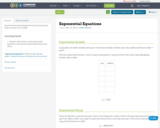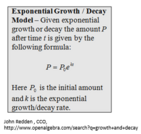
Context based exponential growth and decay questions.
(This is used as a test of OER)
- Subject:
- Mathematics
- Material Type:
- Homework/Assignment
- Date Added:
- 02/19/2019

Context based exponential growth and decay questions.
(This is used as a test of OER)

This seminar will teach you about special types of exponential functions that model growth and decay. You will learn how to distinguish between the two types of functions and also what types of situations are represented by each. You will learn why the specific values in each type of function have the effect on them that they do, and why the terms “growth” and “decay” are appropriate to describe the types of functions. You will see examples of each type of function and why the specific numbers in the functions have the effects of either making the values grow or decay. StandardsCC.2.1.HS.F.1 Apply and extend the properties of exponents to solve problems with rational exponents.

In this lesson, through various examples and activities, exponential growth and polynomial growth are compared to develop an insight about how quickly the number can grow or decay in exponentials. A basic knowledge of scientific notation, plotting graphs and finding intersection of two functions is assumed.

Students act as food science engineers as they explore and apply their understanding of cooling rate and specific heat capacity by completing two separate, but interconnected, tasks. In Part 1, student groups conduct an experiment to explore the cooling rate of a cup of hot chocolate. They collect and graph data to create a mathematical model that represents the cooling rate, and use an exponential decay regression to determine how long a person should wait to drink the cup of hot chocolate at an optimal temperature. In Part 2, students investigate the specific heat capacity of the hot chocolate. They determine how much energy is needed to heat the hot chocolate to an optimal temperature after it has cooled to room temperature. Two activity-guiding worksheets are included.